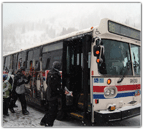Los Angeles to implement contactless fare cards as first step toward regional system
01 September, 2005
category: Contactless, Financial, Library, Transit
 By Andy Williams, Contributing Editor
By Andy Williams, Contributing Editor
The Los Angeles County Metropolitan Transportation Authority (MTA) is set to roll out a smart card-based fare system. What’s unique about the program is that it will take the fare system direct from paper tickets and tokens to the smart card. “Most transit agencies use mag stripe cards (before migrating to smart cards), but not so with Los Angeles,” said Mark Kroncke, director of business development for the western region for Cubic Transportation Systems, the company developing the Los Angeles fare payment system. “L.A. is going from tokens and paper tickets right to smart cards.”
He compared the leapfrog in technology to the way some European countries’ phone systems evolved. “In Eastern Europe they went directly from an antiquated phone system to cell phones, and now everyone has high-tech cell phones.”
Cubic is currently installing the contactless fare boxes on buses. “We’re half way through installation on some 3,000 buses,” said Mr. Kroncke. Right now, bus drivers use the fare boxes to log on when they start their shift.
As an example of the open source technology Cubic is installing, he said the smart card readers for passengers will handle ISO 14443 type A and B standard cards, as well as Cubic’s own Go Card format. The bus drivers are equipped with Mifare cards that double as their ID badge. Other MTA employees use it as their access cards, said Jeffrey Klompus, a consultant in Booz Allen Hamilton’s L.A. office. Booz Allen, he said, was hired as technical consultants by L.A. MTA “to help them develop the technical specifications that were then competitively bid.”
The fare boxes are integrated with the Advanced Transportation Management System (ATMS) that, said Mr. Klompus, helps provide the vehicle location and allows the bus driver to have voice communication with the dispatcher. “We’ve integrated this system with the fare boxes,” he added.
“In L.A. you have two systems, bus and rail,” he said, adding that he expected it will take Cubic until February, 2006 to equip all buses and rail lines. “The whole infrastructure will be in place then. We’ve been working on this since March 2002.”
The original contract price was $84 million, but with the addition of other transit agencies, system improvements, and system enhancements, the project is now closer to $115 million.
A 700,000 card initial order … with 2 million cards by 2008
Mr. Kroncke said L.A.’s initial order is for 700,000 cards that Cubic calls its Go Card. The Go Card is also used in Washington, D.C. (as Smart Trip) and Chicago (as Chicago Card). L.A.’s card will be known as the Tap (Transit Access Pass) Card. “We want to get people used to tapping their card at the reader so they don’t miss the read range,” said Mr. Kroncke.
“Once we get everything installed, we will start a pilot program with the contactless smart card,” said Mr. Kroncke. There will be about 50,000 in the pilot, most of them MTA employees, plus some select groups, such as the area’s larger employers. He estimates the pilot will run three to six months.
He said MTA is expected to have two million cards in circulation by 2008. Obviously MTA will be running parallel systems for a period of time. People won’t be forced to use the smart cards; any changes will be phased in.
Riders can buy a monthly pass or a daily or weekly pass, he added. “If I pay $52 for a monthly pass, I can ride all day every day.” A stored value option will be available to allow the purchase of other things. That’s down the road. “Phase 2 will include something like an e-purse for parking, events (Dodgers games), and retail stores,” he said.
The cards will be available via a mass mail campaign and there will be ticket vending machines at all rail station stops and customer service centers. “Buses will not have ticket vending machines but you’ll have access to a large point-of-sale network (e.g. stores) that are currently selling bus tokens,” he said. There will be “loading machines” where people can add value to their smart cards, he added.
A regional focus
While Cubic started with L.A. Metro, “the plan has always been to make this a regional smart card program,” said Mr. Kroncke. That fits with the Universal Fare System that the various transit agencies in L.A. County and beyond desire.
This Universal Fare System is expected to handle card management for the region. Already, Cubic also has received contracts from nine bus operators across L.A. county, including Long Beach, to provide fare boxes so they can join the regional system.
“This whole project,” said Mr. Kroncke, “was born out of a need to have seamless travel among the various areas in L.A. County. MTA operates throughout the county, but you also have smaller communities served by their own agencies.” Eventually, one card will work on all transit systems in the county, he said.



